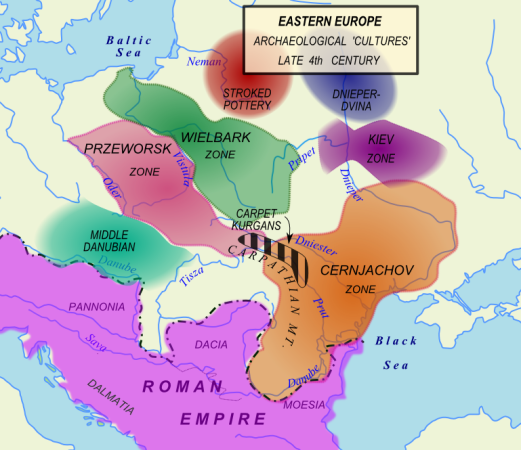If we look at the representation and distribution of haplogroup R-M458 in Germany, we will see the highest representation in the territories of eastern Germany, the further west, the percentage of haplogroup R-M458 decreases. History has recorded the presence of the Slavic peoples in Germany.
I cannot understand the mind of the man who characterized the haplogroup R-M458 as: (Germanо-Slavic).
These are the main and most important branches of the R-M458 haplogroup among Slavs. Unique members of R-M458* and generally those who are * at the top of the tree aged 4000-5000 years with 1-3 members were not taken into account
Phylogenetic tree of haplogroup R-M458 in Slavs:
R-M458>A11460* 2500 ybp
R-M458>A11460>Y85725 1700 ybp
R-M458>A11460>BY202471 1350 ybp
R-M458>PF7521>Y2604>L260* 2700 ybp
R-M458>PF7521>Y2604>L260>YP1337 1850 ybp
R-M458>PF7521>Y2604>L260>YP256 2200 ybp
R-M458>PF7521>Y2604>FGC2608>BY32066 1350 ybp
R-M458>PF7521>Y2604>FGC2608>CTS11962*. 3100 ybp
R-M458>PF7521>Y2604>FGC2608>CTS11962>YP515* 3000 ybp
R-M458>PF7521>Y2604>FGC2608>CTS11962>YP515>YP509 1950 ybp
R-M458>PF7521>Y2604>FGC2608>CTS11962>L1029 2100 ybp
The branch R-L1029 is represented and spread in all Slavic peoples, from Russia to Germany and further south to Greece
The branch R-L260 and its two sub-branches R-YP1337 and R-YP256 are widely distributed, where the Slavs are and where they once were, there are also members of R-L260, from Russia all the way to Germany. Among southern Slavs, it is very little represented.
The branch R-YP509 is most represented among the Western Slavs, but it is also represented among other Slavic peoples.
The branch R-A11460 has three discovered sub-branches, one of those three sub-branches is R-BY202471, the young and most numerous sub-branch of haplogroup R-A11460. Branch R-BY202471 is represented in northern and southern Slavs.
The branch R-BY32066 is a very small and young branch with about ten tested members: We have 5-6 tested Russians from Russia, two Poles and two tested from the same family from some West Asian country.
The gentleman who characterized M458 under the term (Germano-Slavic) is living in a delusion and a lie. This really insults the intelligence of the average person.
This is hypocrisy, partiality and shame for a man who uses lies.
According to the same logic, it can be characterized as members of haplogroup R-U106 (Slavic-Germans)
Because among the Slavic peoples there are members of R-U106 who were Slavized and assimilated.
You see the hypocrisy of the man who characterized the Germanized and assimilated Slavs R-M458 as: (Germano-Slavic). He actually characterized not only Germanized Slavs from Germany and Austria, but also all Western, Eastern and Southern Slavs as a mixture of Germans and Slavs.
I cannot understand the mind of the man who characterized the haplogroup R-M458 as: (Germanо-Slavic).
These are the main and most important branches of the R-M458 haplogroup among Slavs. Unique members of R-M458* and generally those who are * at the top of the tree aged 4000-5000 years with 1-3 members were not taken into account
Phylogenetic tree of haplogroup R-M458 in Slavs:
R-M458>A11460* 2500 ybp
R-M458>A11460>Y85725 1700 ybp
R-M458>A11460>BY202471 1350 ybp
R-M458>PF7521>Y2604>L260* 2700 ybp
R-M458>PF7521>Y2604>L260>YP1337 1850 ybp
R-M458>PF7521>Y2604>L260>YP256 2200 ybp
R-M458>PF7521>Y2604>FGC2608>BY32066 1350 ybp
R-M458>PF7521>Y2604>FGC2608>CTS11962*. 3100 ybp
R-M458>PF7521>Y2604>FGC2608>CTS11962>YP515* 3000 ybp
R-M458>PF7521>Y2604>FGC2608>CTS11962>YP515>YP509 1950 ybp
R-M458>PF7521>Y2604>FGC2608>CTS11962>L1029 2100 ybp
The branch R-L1029 is represented and spread in all Slavic peoples, from Russia to Germany and further south to Greece
The branch R-L260 and its two sub-branches R-YP1337 and R-YP256 are widely distributed, where the Slavs are and where they once were, there are also members of R-L260, from Russia all the way to Germany. Among southern Slavs, it is very little represented.
The branch R-YP509 is most represented among the Western Slavs, but it is also represented among other Slavic peoples.
The branch R-A11460 has three discovered sub-branches, one of those three sub-branches is R-BY202471, the young and most numerous sub-branch of haplogroup R-A11460. Branch R-BY202471 is represented in northern and southern Slavs.
The branch R-BY32066 is a very small and young branch with about ten tested members: We have 5-6 tested Russians from Russia, two Poles and two tested from the same family from some West Asian country.
The gentleman who characterized M458 under the term (Germano-Slavic) is living in a delusion and a lie. This really insults the intelligence of the average person.
This is hypocrisy, partiality and shame for a man who uses lies.
According to the same logic, it can be characterized as members of haplogroup R-U106 (Slavic-Germans)
Because among the Slavic peoples there are members of R-U106 who were Slavized and assimilated.
You see the hypocrisy of the man who characterized the Germanized and assimilated Slavs R-M458 as: (Germano-Slavic). He actually characterized not only Germanized Slavs from Germany and Austria, but also all Western, Eastern and Southern Slavs as a mixture of Germans and Slavs.


